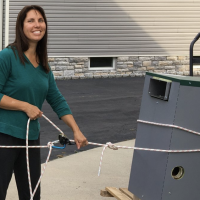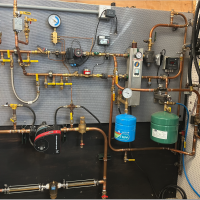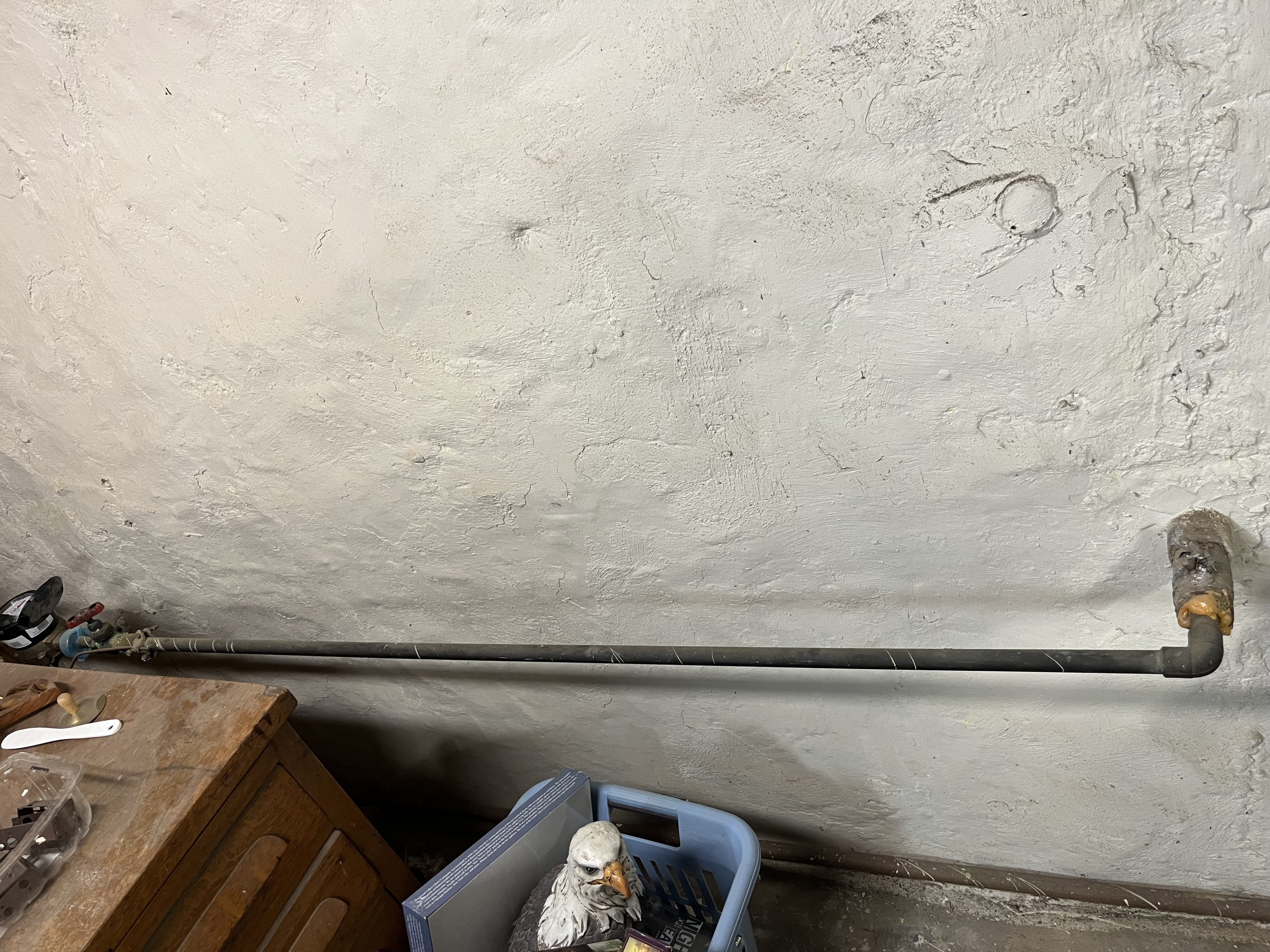Expansion tank waterlogged
I had an hvac tech in the house for regular maintenance. He happened to tap on the expansion tank plumbed over my water heater, told me it was waterlogged and failed and should be replaced.
the tank is only 5 years old. Theres no signs of leaking. Is this as simple as putting a bike pump on the shraeder valve and pumping some more air pressure into it? The house has very high water pressure - over 90 psi last time i put a gauge on the system. It might have not had enough air pressure from day one.
Comments
-
If you push on the Schraeder, does water come out? If not the tank is fine
Trying to squeeze the best out of a Weil-McLain JB-5 running a 1912 1 pipe system.0 -
-
-
-
rigged up a gauge a few years ago prior to installing a RO filter to the kitchen sink. My 90+ psi figure is probably imprecise. I can’t tell you the gauge was calibrated all that well but i think its safe to say the pressure is on the very high side. i bought a prv for the ro system.
The ro system was a diy job. I’d have to call someone to put a prv on the whole house.
And then i might miss the high pressure shower
0 -
OK so the idea of the expansion tank on a DHW system is to allow for water in the potable water piping to expand when the water heater has a tank of cold water (maybe below 60°F) from almost running out of hot water (after a teenaged daughter showers). That tank may have an average water temperature of 70°F when all the taps are closed. Lets say you have a 40 Gallon tank and another 5 gallons of water in the rest of the pipes. When the water heater burner stops heating the water in the tank, the expansion can make that water go from 45 gallons total to 49 gallons total. Where does that extra 4 gallons of water go?
If you have a check valve of any type near your water meter, the expanded water can not flow back to the water main in the street. If your water pipes are full of water and there is no air space at the top of the DHW tank, than Hydraulic pressure will build up, and pressure will go from 90 PSI to 150 PSI in pretty short order, and the relief valve on the DHW Tank will discharge the extra pressure (or maybe 125 PSI)
If you use that expansion tank and the out of the box pressure was set at the factory at 45 PSI, then when you turn on the water feed to the water heater, the 90 PSI cold water will compress that air in the tank to 90 PSI by adding 3 gallons of water to that 5 gallon tank. That means there is only 2 gallon of air left to absorb any expansion. That may not be enough for the 4 gallons that may happen from time to time.
In order to get the full use from the expansion than, your air pressure in the tank when it is not connected to the pressure of the potable water system, should be close to the operating pressure of the system. So turn off the cold water feed valve and open a hot faucet to drop the system pressure or zero or as close as you can get to zero. Measure the air pressure in the tank. If the air pressure is below the operating pressure of the home's cold water pressure, then you need to increase the air pressure in the tank to match the operating pressure of the system.
- In your case, place a pressure gauge on your system and take a reading. let's say 90 PSI
- Next, Close the cold water inlet to the home.
- Open a hot water tap in the home
- Measure the air pressure in the tank (in your case let's say that it has the factory charge of 45 PSI).
- With a pump or compressor add pressure to get the tank air pressure to 90 PSI.
- Close the hot water tap.
- Open the cold water feed to the home.
- Check the water pressure in the home. should be 90 PSI.
As far as @pecmsg's comment about the water pressure in your home being a little high, I agree. You should invest in a pressure reducing valve at the inlet to your home. regulate that pressure down to about 60 PSI. That is plenty of pressure for most operations in a residence. You will save on future repairs to fixtures and faucets. If you do get the pressure down, then adjust the expansion tank to 60 PSI pressure also. Remember the air pressure MUST be measures when there is no water pressure in the system.
Edward Young Retired
After you make that expensive repair and you still have the same problem, What will you check next?
0 -
I assume this is city water not well.
If yes there should be a back flow preventer and regulating valve already there.
0 -
-
-
yes city water. Just outside Philadelphia.
here are shots of the line coming into the house. Looks to my untrained eye like a couple of stop valves and the meter. Is there a prv there?
@jamiehallHe was looking for a different sound between the front half (water filled) and back half (air filled) of the tank and didn’t hear one. Based on no air coming from the shraeder when i bled it, it makes sense its 100% water filled.
0 -
- good question
- You mean the prv on the hot water heater? No its never released water
0 -
that just means it lost the air. Now if you got water out of the valve then it was water logged.
shut the main valvesOpen faucets
Drop the pressure to zero
Pump the tank up to 90
0 -
thanks all. This all makes sense to me. Ill look into getting a regulator on the house. Weve been having a leaky washer and I didn’t think until now the high pressure might be why
0 -
look into auto shutoff systems. Many times your homeowners ins will cover all if not part of.
0 -
-
you mean a leak detection/shutoff type product? Probably a good idea
0 -
is the expansion tank i have large enough? I can’t see the specs but it cant be larger than two gallon. I think the water heater is 50 gallon. It was put in by a pro when he put the new water heater in. I didn’t even have an expansion tank with the old heater (but apparently i have no backflow prevention either!!)
0 -
That tank is large enough, IF it is pressurized properly.
Although without a backflow device anywhere the tank isn't really doing anything.
My experience is you can tell a waterlogged tank by wiggle or tapping on it. A hollow air filled tank is a few lbs, a water logged one could be 30lbs or more.
If it is starting to sag downward it may be another indication.
It is rare these days not to have a backflow device on your incoming water line., it protects the entire city water systems from contamination.
Bob "hot rod" Rohr
trainer for Caleffi NA
Living the hydronic dream0 -
recommend you strap it to rafter or use another method to support the tank. That’s a big lever you have there and the copper may fail dramatically given enough load.
PS: what @EBEBRATT-Ed said!0 -
Yep. I hear ya. I am seeing brackets to mount it the side of the tank. probably better than hanging from the rafters. Ive got a plaster ceiling up there which only seems so attached to the lathe.
i think this will work. And yeah, i think i should call someone about getting a prv and leak detection put onhttps://www.supplyhouse.com/Sioux-Chief-598-023-3-Piece-TankBracket-w-2-Nylon-Straps-for-Water-Heater-Mount-Arm-Leg-Foot
1 -
@trivetman Said: "Based on no air coming from the shraeder when i bled it, it makes sense its 100% water filled."
That is not good. You basically have a 2.5 gallon storage tank on your system where the water can get static and stagnant where bacteria can grow nicely. There is no water movement in and out on a regular basis if there is no air pressure in the tank. Your water service line in the basement does not appear to have a check valve or BFP anywhere visible. So you may not need that tank.
Because you may have nasty stuff in that tank, I would remove it and wash it out with some bleach before charging it with the proper water pressure and reconnecting it to your water system. (Or just purchase a new one)
As far as the water from a 50 gallon water heater expanding by 3 gallons when increasing temperature, those numbers were used as an example only. The exact amount of expansion of 50 gallons of water from 58° to 125° is a little less than 2 gallons. That will only happen if you turn off the water heater and completely empty the tank of the water that is in there. Then put 50 gallons of cold water in it. Then turn on. the water heater and let it get to 125° without opening any water taps in the system. Just open one hot or cold water tap and the pressure will drop to the normal pressure from the city water pressure. So your small 2.5 gallon tank is fine
If there is no back-flow preventer or check valve between your water meter and the water main in the street, then the expanded water will just flow backwards into the water main in the street. Eventually the water company will be adding that check valve to your system. So don't get rid of that expansion tank. It may be useful someday soon.
Edward Young Retired
After you make that expensive repair and you still have the same problem, What will you check next?
0 -
thanks all for the advice on this. Ive got a bracket on the way to reposition the tank. Will be looking into a prv on the house.
i am also going to make an attempt to replace the plastic drain port and put in a full port ball valve and brass nipple. From what Ive read, the plastic pipe can be a real bear to remove and it seems a hacksaw blade through the interior can become the answer. Any advice on dealing with this? Internal pipe wrench maybe?0 -
Hi, About replacing the plastic drain on the water heater… It's probably safest to drain the tank first. Then you just try to unscrew the drain valve. I often do this with a basin wrench that has a square shank and a crescent wrench on that shank. This gives a good grip. If the valve breaks off, I take a hacksaw blade and cut part way through the plastic. I don't want to risk damaging the threads in the tank. Then use a small flat screwdriver and light taps with a hammer to drive the plastic inwards, away from the metal threads of the tank. Now the piece will pull out. Next, use a plastic lined, steel nipple between tank and full port ball valve. Finally a brass hose adapter into the valve. This approach has worked for me. It doesn't cause any galvanic corrosion either. 😎
Yours, Larry
0 -
There should be two flat sides to put a wrench on the plastic drain valve. Try not to put sideways force on it.
If you remove the handle and bonnet nut you have a straight shot at the flats.
A large crescent, channel locks are my choice. A pipe wrench can egg shap the plastic and make it harder to un-screw.
And, yeah they do break occasionally, as the plastic tends to get brittle as it ages. Then it is the hack saw blade trick
Bob "hot rod" Rohr
trainer for Caleffi NA
Living the hydronic dream0 -
thanks. The plastic drain is of the style in the pic below. There is a hex nut behind the cap. I tested a wrench to it a while back and the torque just seemed to twist the pipe out of shape. That was with the tank full and I was just seeing if it had any give to it. Maybe itll act differently without pressure behind it.
Is using an internal pipe wrench not likely to make it easier? I was thinking that would deliver force to the section of pipe at the threads without torquing the pipe between the hex and where the threads are.
i bought a brass nipple for it, not steel with lining. Not the right material?0 -
Screw the big handle CCW all the way, then turn it CW. There is a left hand thread inside that allows the big handle and stem assembly to come out.
Maybe then you can get a large 6 point, or faucet socket on it. That will help to not distort the plastic. I suspect that is how they install them at the factory.
Bob "hot rod" Rohr
trainer for Caleffi NA
Living the hydronic dream1 -
Hi, About the question of brass vs plastic lined steel nipple, the latter is better for this purpose…. particularly if the water has much hardness in it, or is softened.
Yours, Larry
0 -
That is a lot of weight on the pipes. An accident waiting to happen. I never like to see the copper pipes take the weight of an expansion tank, waterlogged or not.
Install something like this with the new tank, or even the current one if it only needs air.
These two items work great when installing an expansion tank and bear all of the weight.
3 -
-
-
new tank mounted. Full port drain on the bottom. New anode on the way which will go in next week. No disasters.
A 3/4 internal pipe wrench took out the plastic nipple real easily when any external wrench on the plastic hex just twisted the pipe without transferring any of the force to the threads. I didn’t have to resort to the hacksaw and chipping it out with a screwdriver.0 -
-
Categories
- All Categories
- 87.3K THE MAIN WALL
- 3.2K A-C, Heat Pumps & Refrigeration
- 61 Biomass
- 427 Carbon Monoxide Awareness
- 119 Chimneys & Flues
- 2.1K Domestic Hot Water
- 5.8K Gas Heating
- 115 Geothermal
- 165 Indoor-Air Quality
- 3.7K Oil Heating
- 76 Pipe Deterioration
- 1K Plumbing
- 6.5K Radiant Heating
- 395 Solar
- 15.6K Strictly Steam
- 3.4K Thermostats and Controls
- 56 Water Quality
- 51 Industry Classes
- 49 Job Opportunities
- 18 Recall Announcements




















